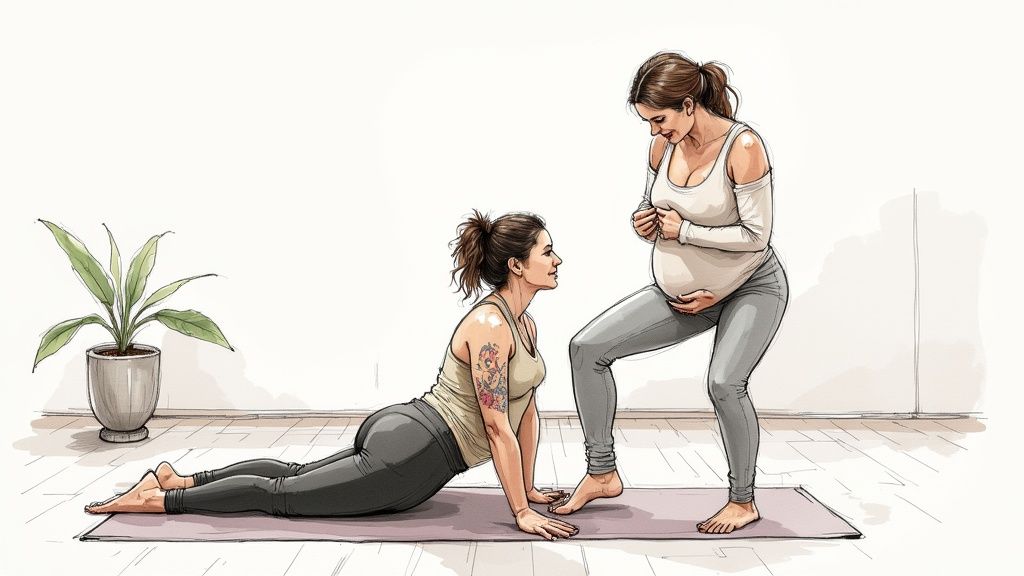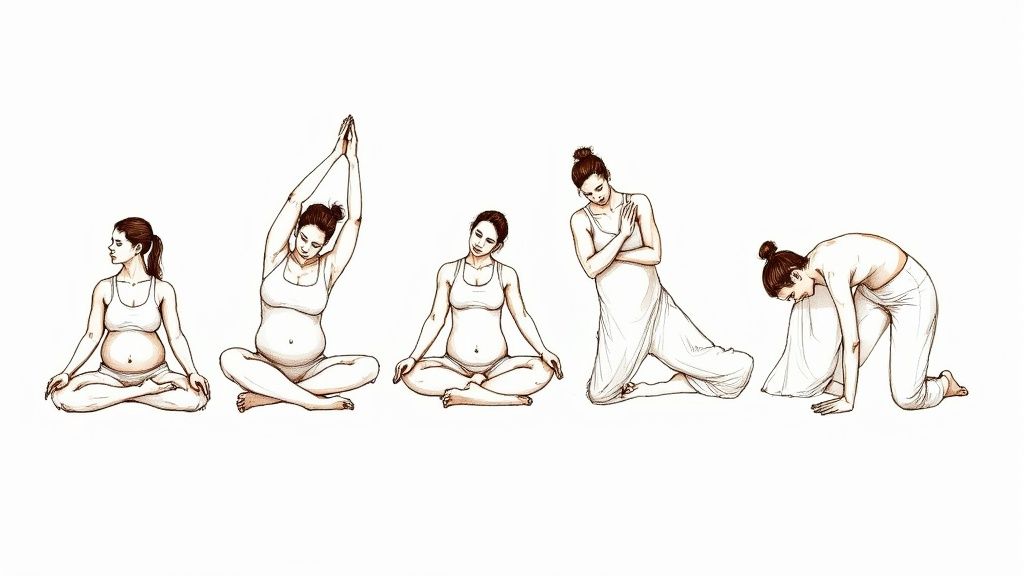Understanding the Benefits of Prenatal Yoga

Pregnancy brings profound changes to a woman’s body and mind. Many expectant mothers seek ways to stay healthy and comfortable during this special time, making prenatal yoga an excellent choice. These specialized classes offer much more than basic stretching – they provide a complete approach to supporting both physical and emotional wellbeing throughout pregnancy. Let’s explore the many ways that regular prenatal yoga practice can benefit expecting mothers.
Physical Benefits of Prenatal Yoga
Research shows that practicing prenatal yoga can make a real difference during labor and delivery. Many women who take these classes experience shorter labor times and higher rates of natural births. This makes sense since the practice builds strength in key muscle groups while improving flexibility and teaching effective breathing techniques – all vital skills for childbirth. Simple poses like squats and gentle hip openers help prepare the pelvis and surrounding muscles for delivery.
Prenatal yoga can also help relieve common pregnancy discomforts. As your belly grows and your body changes shape, you might experience back pain, sciatica, or swelling in your legs and feet. The gentle movements and specific stretches taught in prenatal classes target these exact issues. The practice also includes exercises to help you stay steady and balanced as your center of gravity shifts forward. Many women find they can move more comfortably and confidently throughout their pregnancy thanks to regular yoga practice.
Emotional and Mental Well-being
The benefits go far beyond the physical – prenatal yoga offers powerful tools for emotional balance. The breathing exercises and mindfulness practices help reduce stress and anxiety naturally. This is especially helpful during pregnancy when shifting hormones can intensify emotions. Regular practice gives you reliable ways to stay calm and centered.
The mindful movement in prenatal yoga also helps you build a stronger connection with your changing body. As you focus on gentle poses and breathing, you become more aware of physical sensations and emotions. This deeper body awareness often leads to greater self-acceptance and confidence during a time of major physical changes. The practice creates space to embrace pregnancy’s changes while staying grounded and peaceful.
Finding the Right Pregnancy Yoga Class Near Me
Thanks to growing interest in prenatal yoga, finding nearby classes is usually straightforward. The key is choosing one specifically designed for pregnant women and led by an instructor trained in prenatal yoga. This ensures you’ll learn modifications that keep you and your baby safe through each stage of pregnancy.
When searching for local classes, look beyond just location. Seek out a welcoming environment where you feel comfortable asking questions and connecting with other moms-to-be. The social aspect of prenatal yoga classes can be just as valuable as the physical practice – it’s a chance to build friendships with women sharing similar experiences. Taking time to find the right class will help you make the most of this special practice during your pregnancy journey.
Starting Your Pregnancy Yoga Journey at the Right Time

When I first considered joining pregnancy yoga classes, timing was one of my main concerns. Like many women, I wondered if there was an ideal point to begin – before pregnancy, during the first trimester, or later? What I discovered was reassuring: you can start pregnancy yoga at any stage, as classes are designed to adapt to each phase of pregnancy with specific modifications.
First Trimester: Building a Foundation
The first trimester can be challenging with morning sickness and fatigue, but gentle yoga flows can help ease these symptoms. During this early stage, the focus is on connecting mindfully with your changing body through simple, restorative poses. Think of these initial practices as getting to know your pregnant body – observing new sensations and learning to move with awareness. My local pregnancy yoga classes offered plenty of options to work around early pregnancy discomfort.
Second Trimester: Embracing Strength and Stability
Many women find renewed energy in the second trimester, making it a natural time to explore more active poses. The practice shifts to building strength and stability through standing poses, hip openers, and gentle core work. These movements help support your growing baby and maintain good posture as your body changes. During this stage, I found that regular classes helped me stay strong and flexible as my pregnancy progressed.
Third Trimester: Preparing for Birth
The final trimester brings another shift in focus. As your due date approaches, classes emphasize comfort, relieving pressure, and preparing for labor. You’ll practice useful breathing techniques, gentle stretches, and exercises to strengthen your pelvic floor. This is when many women find the mindfulness and relaxation elements of yoga especially helpful. By this point in my pregnancy, my weekly yoga class had become an essential part of my routine.
Listening to Your Body and Finding the Right Class
The key is to begin when it feels right for you, whether that’s early in pregnancy or later on. Every woman’s pregnancy journey is different, so it’s important to find a class that matches your needs and comfort level. Be open with your instructor about any concerns, and don’t hesitate to modify poses as needed. Taking this flexible approach will help you create a sustainable practice that supports you throughout your pregnancy, regardless of when you start.
Choosing Your Perfect Prenatal Yoga Class
When searching for pregnancy yoga classes in your area, location is just one piece of the puzzle. Your physical comfort, safety, and emotional wellbeing during pregnancy depend on finding the right class environment and instructor. Taking time to evaluate your options will help you get the most out of this nurturing practice.
Key Considerations When Choosing a Class
Finding a prenatal yoga class that fits your needs involves looking at several important factors that will shape your experience. Here’s what to keep in mind as you explore your options:
- Instructor Qualifications: Look for teachers who hold specific certifications in prenatal yoga. This specialized training means they understand how to safely guide pregnant women through modified poses while respecting the unique changes happening in their body. Think of it like choosing your care provider – you want someone with the right expertise.
- Class Atmosphere: The right environment makes a big difference. Search for classes where you feel welcomed and supported by both the teacher and other moms-to-be. This shared experience often creates meaningful connections with women going through similar experiences.
- Class Size and Structure: Consider whether you’d prefer more personal attention in a smaller class or the energy of a larger group. Some classes focus on building strength and stamina, while others emphasize gentle movement and breathing. Choose a format that matches your goals and comfort level.
Asking the Right Questions
Before joining a class, have an open conversation with potential instructors. Getting clear answers will help you make an informed choice:
- Experience with Prenatal Yoga: Ask about their specific background in teaching pregnant women. Regular yoga teaching experience is valuable but different from the specialized knowledge needed for prenatal classes.
- Modifications and Adjustments: Find out how they adapt poses for different stages of pregnancy and individual needs. A good instructor should readily explain their approach to keeping you safe and comfortable.
- Safety Protocols: Don’t shy away from questions about safety. Quality instructors will be happy to explain how they prevent injury and handle any concerns that come up during class.
Evaluating Class Styles and Studio Safety
The teaching style and physical space play key roles in creating a positive experience:
- Different Teaching Styles: Each instructor brings their approach. Some offer hands-on assistance while others guide through detailed verbal cues. Visit a class to see if their teaching method helps you feel confident and supported.
- Studio Safety and Hygiene: Check that the space is clean, well-ventilated, and properly maintained. Picture yourself practicing there regularly – you should feel at ease in the environment.
- Red Flags to Watch For: Pay attention if an instructor dismisses your concerns or pushes you beyond comfortable limits. Your instincts about safety and comfort matter – listen to them.
Finding the right prenatal yoga class takes some time and attention, but it’s worth the effort. By considering these elements carefully, you’ll discover a practice that supports your wellbeing throughout pregnancy. This thoughtful approach helps ensure you get the most benefit from your prenatal yoga journey.
Starting Your First Pregnancy Yoga Session

Starting a pregnancy yoga class for the first time brings a mix of excitement and uncertainty. It’s completely normal to feel this way. This section will walk you through what to expect, help calm any worries, and show you how to get the most out of your practice. We’ll cover everything from your first class experience to connecting with other moms-to-be, so you can begin your practice with confidence.
What to Expect in Your First Class
Your first class will introduce you to the basics in a gentle, welcoming way. The instructor will guide you through modified poses that work for your stage of pregnancy. You’ll likely use supportive props like blocks and bolsters to help you move safely and comfortably. For instance, a bolster under your knees during reclined poses helps take pressure off your lower back. The class will also teach breathing techniques that can help during labor like deep belly breathing and calming exhales.
Building Connections in Your Pregnancy Yoga Community
One of the best parts of pregnancy yoga is meeting other expectant mothers. The class provides a natural space to share experiences and form friendships with women going through similar changes. You might chat before class about morning sickness remedies or compare notes on baby gear after practice. These connections often extend beyond the yoga studio, creating a support network that makes pregnancy feel less overwhelming.
Tips for a Comfortable First Session
A few simple preparations can help your first class go smoothly. Wear loose, stretchy clothes that let you move freely and keep you comfortable as you warm up. Getting to class 10-15 minutes early gives you time to meet your teacher, set up your mat, and settle in without rushing. Don’t hesitate to tell your instructor about any physical concerns or limitations – they’re there to help adjust poses to work for your body.
Managing First-Class Jitters
Feeling nervous before your first class is something many women experience. Taking some deep breaths before you arrive can help calm those butterflies. Picture yourself enjoying gentle movement and relaxation among other moms-to-be. If you’re still anxious, reach out to the instructor ahead of time with questions – they’ve helped many first-timers feel at ease. Remember that pregnancy yoga welcomes you exactly as you are, whether you’re a complete beginner or have practiced before. Every class offers a chance to tune into your changing body and connect with your baby in a nurturing environment.
Making Safety Your Top Priority in Prenatal Yoga
When attending a pregnancy yoga class near me, it’s essential to put safety first. This guide covers how to adapt poses by trimester, spot warning signs, and find the right instructor for a secure practice.
Understanding Modifications Throughout Your Pregnancy
Your yoga practice needs to evolve alongside your changing body during pregnancy. While an experienced instructor will guide you through safe modifications, knowing the basics helps you make smart choices for yourself at each stage.
- First Trimester: Many women experience tiredness and morning sickness during these early months. Keep your practice gentle with basic poses, restorative work, and breathing exercises. Skip inversions and any poses that press into your belly. Think of this time as getting to know your changing body – moving slowly and mindfully as you build awareness.
- Second Trimester: As your energy returns, you can do more active poses while respecting your growing bump. Avoid deep twists and backbends that could strain your muscles. Make space by widening your stance in standing poses and using props like blocks for support. Your practice should open up just like your body is expanding to nurture your baby.
- Third Trimester: With your center of gravity shifting, your balance becomes trickier. Focus on poses that ease discomfort, especially around your hips and lower back. Don’t lie flat on your back since this can affect blood flow. Breathing practices and relaxation become key preparation for labor. Think of this phase as building stamina and calm for the journey ahead.
Recognizing Warning Signs
While pregnancy yoga is safe for most women, knowing when to pause is important. Stop practicing and check with your doctor if you notice:
- Vaginal bleeding: Get immediate medical care for any bleeding
- Dizziness or shortness of breath: Could signal low blood sugar or other concerns
- Headaches: Especially if severe or ongoing
- Calf pain or swelling: May indicate circulation issues needing evaluation
- Uterine contractions: While Braxton Hicks are normal, painful or regular contractions need checking
Stay tuned in to how your body feels and keep open communication with your instructor. Regular check-ins help catch any issues early.
Choosing a Qualified Instructor for Your Pregnancy Yoga Classes Near Me
Finding the right pregnancy yoga classes near me makes a big difference in having a safe, beneficial experience. Look for teachers with specific prenatal yoga certifications who understand the physical changes of pregnancy. Ask about their background, how they modify poses, and their safety guidelines. Just as you’d carefully choose your healthcare providers, picking a qualified instructor ensures proper guidance.
Adapting Common Yoga Poses
Many standard yoga poses work well during pregnancy with smart modifications. For instance, widen your hands and feet in downward-facing dog to make room for your belly. Practice triangle poses near a wall for extra support. A good instructor shows you how to adjust poses to fit your changing needs while maintaining their benefits. These tweaks are like customizing clothing – the same basic structure but fitted perfectly for you. Finding pregnancy yoga classes near me led by certified teachers helps you move safely through this special time while preparing for birth.
Building Your Pregnancy Support Network Through Yoga

Local pregnancy yoga classes offer a wonderful opportunity to connect with other moms-to-be while taking care of your physical and emotional wellbeing. The friendly, supportive environment helps you build meaningful relationships during this special time. When you join a class, you’re not just investing in prenatal exercise – you’re becoming part of a caring community that can support you through pregnancy and beyond.
The Power of Shared Experience
In pregnancy yoga class, you’ll meet other women going through similar physical changes and emotions. There’s something incredibly comforting about being able to chat openly about morning sickness remedies or share your excitement about feeling those first baby kicks. The casual conversations before and after class help normalize common pregnancy experiences that can sometimes feel isolating. Many women find that having a safe space to voice their hopes and concerns makes them feel more confident and supported.
Building Connections Beyond the Mat
The friendships formed in pregnancy yoga often grow into lasting relationships that continue well after the baby arrives. Having a network of mom friends becomes especially valuable during those early weeks of parenthood when you’re figuring out feeding, sleep schedules, and your new normal. Meeting up for walks with the babies, sharing tips over coffee, or just texting each other for moral support can make such a difference. These authentic connections help new moms feel less alone during the big transition into motherhood.
Strategies for Connecting With Fellow Practitioners
To benefit from the community aspect of pregnancy yoga, try these simple ways to connect with your classmates:
- Arrive Early and Stay After: Use the time before and after class to chat casually and get to know people
- Participate in Class Discussions: Share your experiences and listen supportively when others share theirs
- Exchange Contact Information: Swap phone numbers or emails with people you click with so you can keep in touch
- Suggest Social Gatherings: Organize simple meetups like walks in the park or coffee dates to strengthen friendships
Maintaining Connections Postpartum
With a little effort, the support network you build during pregnancy can stay strong after your baby arrives. Here are some ways to maintain those important friendships:
- Join a Mom’s Group: Look for postpartum yoga or parent-baby classes at your studio
- Schedule Regular Playdates: Set up casual meetups that work with nap and feeding schedules
- Create Online Communication Channels: Start a WhatsApp or Facebook group to easily share updates and stay connected
Having supportive mom friends makes such a difference during pregnancy and early parenthood. Your local pregnancy yoga class is the perfect place to meet other women on the same journey. By actively participating in the community, you can develop meaningful friendships that help you thrive during this special time.
Looking for additional support and guidance during your pregnancy journey? Check out Pregnancy 101 for expert-led live sessions, prenatal and postnatal care, and a supportive community of Indian moms-to-be.

